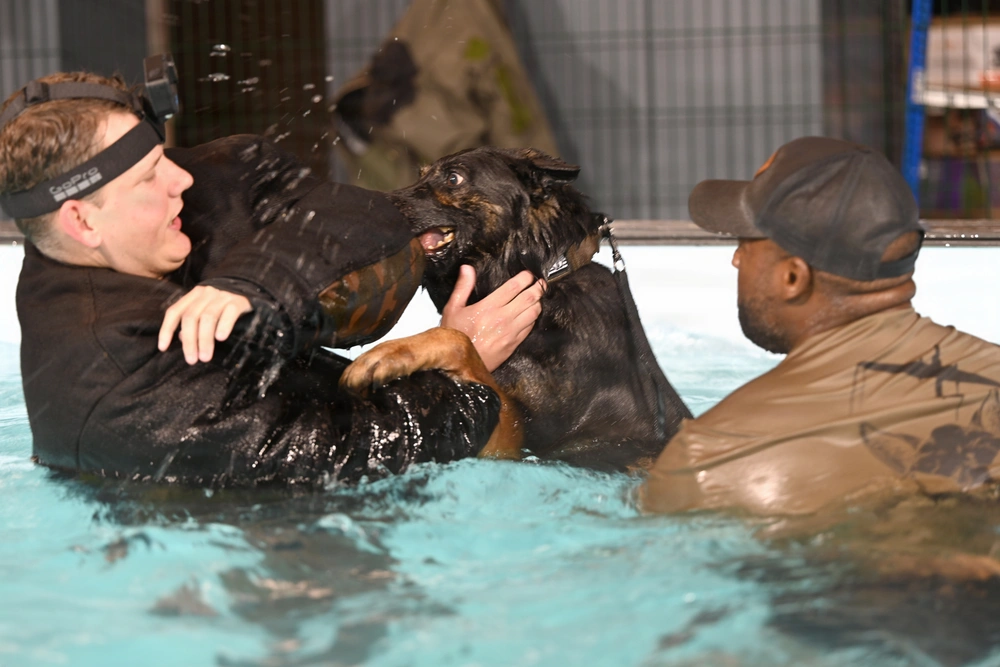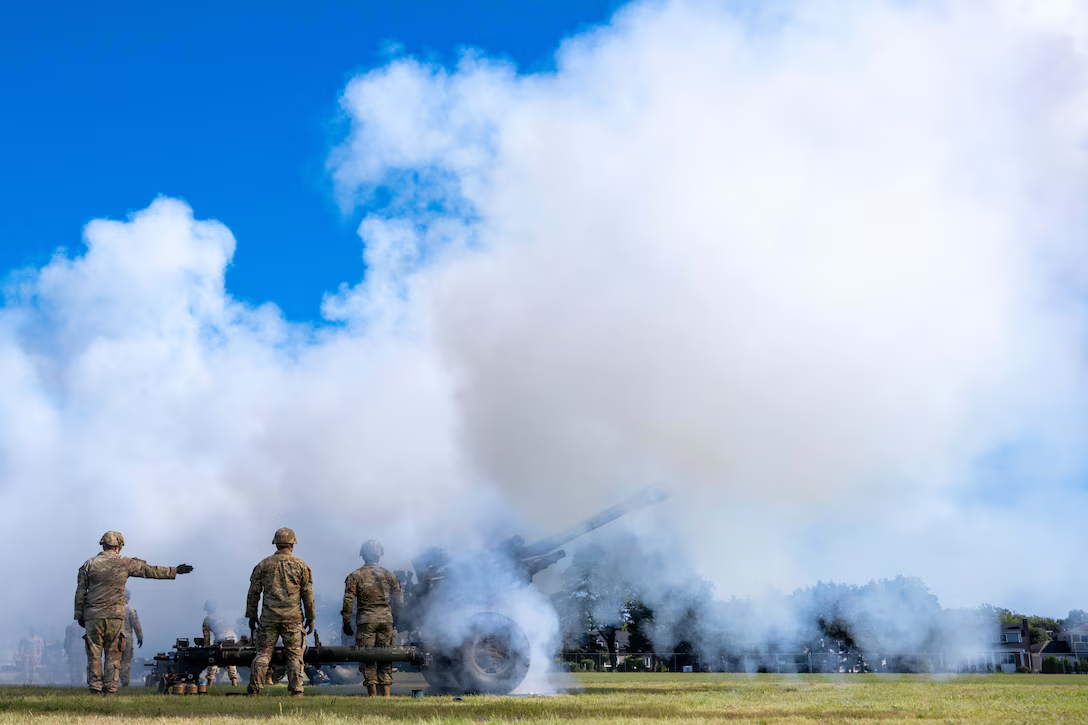- Details
- Hits: 202

RAF MILDENHALL, SUFFOLK, UNITED KINGDOM, (November 11, 2025): U.S. Air Force Staff Sgt. Cameron Gilbert, left, 100th Security Forces Squadron military working dog trainer, braces himself as MWD Glen grips onto the bite suit while Staff Sgt. Julian Benjamin, 100th SFS MWD handler, holds onto the leash during water confidence training in a pool at RAF Mildenhall, England, Nov. 12, 2025. This was the first time this type of training has been conducted at RAF Mildenhall and the tri-base area, and the goal is to build confidence in the working dogs, so they are able to conduct operational tasks while in the water. The training strengthens the overall readiness and force projection capability through building MWDs’ confidence in the water and bolsters the 100th Air Refueling Wing’s ability to forward-deploy in austere environments. (U.S. Air Force photo by Karen Abeyasekere)
- Details
- Hits: 472

NATIONAL GUARD TRAINING CENTER IN SEA GIRT, N.J., (September 14, 2025): New Jersey National Guard soldiers fire M119A3 howitzers during the New Jersey National Guard Military Review. Credit to Army National Guard Sgt. Michael Schwenk
- Details
- Hits: 256

MARINE CORPS BASE QUANTICO, VA., (September. 10, 2025): Marine Corps Basic School students run toward a building as part of a simulated platoon raid during a field exercise designed to develop confident provisional rifle platoon commanders. Credit: Marine Corps Cpl. Joshua Barker
- Details
- Hits: 200

CARIBBEAN SEA, (Novermber 2, 2025): USS Iwo Jima (LHD 7) U.S. Sailors, assigned to the Iwo Jima Amphibious Ready Group, receive a pallet of cargo on the conning station aboard Wasp-class amphibious assault ship USS Iwo Jima (LHD 7) during a replenishment-at-sea with Henry J. Kaiser-class fleet replenishment oiler USNS Patuxent (T-AO-201) while underway in the Caribbean Sea, U.S. military forces are deployed to the Caribbean in support of the U.S. Southern Command mission, Department of War-directed operations, and the president’s priorities to disrupt illicit drug trafficking and protect the homeland. (U.S. Navy photo by Petty Officer 2nd Class Joseph Miller)
- Details
- Hits: 259

HIJUDAI MANEUVER AREA, JAPAN (September 15, 2025): Marines fire an FGM-148 Javelin during Resolute Dragon 25. The U.S.-Japan exercise strengthens the countries' command, control and multidomain maneuver capabilities in key maritime terrain. Photo credit, Marine Corps Lance Cpl. Rodney Frye
- Details
- Hits: 1128

Since the 1960s, the “Me Generation” has gradually rebuilt American culture to take from others, avoid personal responsibility, and pursue self-gratification without duty.
But through it all has shone a bright spot.
America's veterans. Those who stepped up to protect and defend others. Those who gave the best years of their lives not living the good life at the mall or raking in the benefits taken from others, but raising families on meager military salaries in hard circumstances not of their own making, in order to protect others.
An example to all. They were always there for America.
Keeping the dark forces at bay. All American’s should follow their example. The character of America’s veterans, servicemen, and servicewomen has been a constant through all the social flux. They sign-up to do good for others. And when they return to civilian life they are often found continuing to do good for others.
Their hand is not out, except to help you up.
To do good. To build up. To better. To improve. To create.
You don't have to be brave enough to offer your hand. But when you're standing in line and see someone wearing something that shows they’re a veteran, you can easily look at them and simply say “thank you for protecting me and my family.”
It's the right thing to do. A step in the right direction. To acknowledge their hard work on your behalf.
To show them you were worthy of their efforts.
- SPECIAL FORCES ADVANCED URBAN COMBAT COURSE
- 82ND EQRS CONDUCTS JUMP PROFICIENCY TRAINING
- U.S. COAST GUARD CUTTER CAMPBELL ASSISTS ROYAL TURKS AND CAICOS ISLAND POLICE WITH HAITIAN INTERDICTION
- USS IWO JIMA CONDUCTS LCAC OPERATIONS
- 22ND MEU CONDUCTS A LIVE FIRE EXERCISE
- U.S. FORCES STRIKE ELN‑LINKED VESSEL IN USSOUTHCOM WATERS


